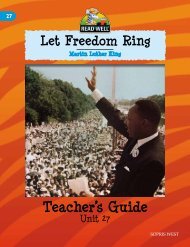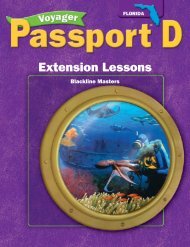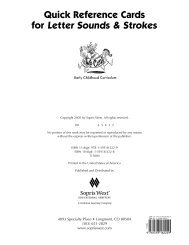Unit 19 - Voyager Learning
Unit 19 - Voyager Learning
Unit 19 - Voyager Learning
Create successful ePaper yourself
Turn your PDF publications into a flip-book with our unique Google optimized e-Paper software.
STORY READING 3 • Flat Stanley, Chapter 3WITH THE TEACHERCHAPTER 3 INSTRUCTIONSStudents read pages 22–27 with the teacher and pages 28–33 on their own.Note: If you’re working on a 9- to 12-Day Plan, you will read pages 28–33with students.COMPREHENSION PROCESSESRemember, Understand, Apply, Analyze, Create, EvaluatePROCEDURES1. Reviewing Chapters 1 and 2Summarizing; Identifying—Events, What; Making Connections; Using Vocabulary—absurd, unique• Quickly review Chapters 1 and 2. Say something like:In Chapters 1 and 2, there were several absurd events. What was the first absurd event?(A bulletin board fell on Stanley, and he ended up as flat as a pancake.)Was Stanley hurt? (no) That’s absurd too. It’s unbelievable. What else was absurd?Would you like to be flat? Why or why not? (Yes, it would be fun and special.)• Discuss the questions from Chapter 2, Setting a Purpose. Say something like:Yesterday, you read pages 16–21 on your own. Let’s see what you found out.What did Stanley do that was absurd? (He was mailed to California.)Why was Mrs. Lambchop nervous? (Stanley had never been away from home.)Think aloud.That’s interesting. If I were Stanley’s mom, I would have been worried about his gettingbumped around in the mail! I would have worried about him getting sent to the wrong address.Why was it awesome to be flat? (Stanley could do all kinds of interesting things. He couldtravel by mail, go under doors . . . )Stanley was one of a kind. He was . . . unique.CorrectingDecodingErrors2. Introducing Chapter 3Identifying—Title; PredictingDiscuss Chapter 3. Say something like:What’s the title of this chapter? (Stanley the Kite)What do you think will happen to Stanley in this chapter? (Stanley will become a kite.)3. First Reading• Ask questions and discuss the story as indicated by the blue text in this guide.• Mix group and individual turns, independent of your voice.Have students work toward a group accuracy goal of 0–5 errors.• After reading the story, practice any difficult words.Reread the story if students have not reached the accuracy goal.4. Second Reading, Short Passage Practice: Developing Prosody• Demonstrate expressive, fluent reading of the first few paragraphs.• Guide practice with your voice.• Provide individual turns while others track with their fingers and whisper read.• Repeat with one paragraph or page at a time.During story reading,gently correct any error,then have students rereadthe sentence.48





